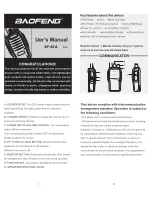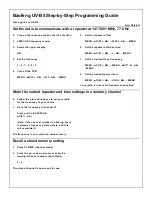
SMARTNET/SMARTZONE/P25 TRUNKED FEATURES
48
6.12.3 SCAN LIST EDITING AND SELECTION
SMARTNET/SmartZone and P25 Trunked scan
lists are user programmable if the
SCN ED
option
switch is programmed. The procedure is described in
Section 4.12.1.
With SMARTNET/SmartZone and P25 trunked
operation, each channel (talk group) can be
programmed to select one of the programmed scan
lists or so scanning is disabled (No List). In addition,
each channel can be programmed so that scanning is
automatically enabled (Auto Scan) when it is selected.
If the
SN LIST
option switch is programmed, the
list that is selected by all talk and announcement
groups in the current system can be temporarily
changed by the user as follows. Also selectable if
desired is “No List” (scanning disabled) or
“Programmed” (default list). The programmed default
list is automatically reselected at power up.
Proceed as follows to temporarily change the
currently selected scan list:
1. With scanning disabled (the rotating
icon is not
indicated in the right status display), press the
SN
LIST
option switch.
2. The currently selected list is displayed as “List x”,
with “x” the currently selected list. To exit without
changing the selected list, simply press the
SN LIST
option switch again.
3. To select another list, “Programmed”, or “No List”,
rotate the Select switch. When the desired list is
displayed, select it and exit this mode by pressing
the Scan List option switch again.
6.13 DYNAMIC REGROUPING
The dynamic regrouping feature allows a
dispatcher to change the current talk group or switch
mobiles to a predefined regrouping channel to receive
an important message. When the console issues a
regroup order, the radio switches to the prepro-
grammed regroup talk group.
If the Cancel Dynamic Regrouping option switch
is programmed, it can be pressed to exit the dynamic
regrouping mode.
Otherwise, if the lock mode was not specified, the
selected talk group can be manually changed and the
previous talk group is reselected if power is cycled. If
a locked regroup command is received, the displayed
talk group cannot be changed manually or by cycling
power. It can be changed only after a clear order is
received from the console.
Dynamic regrouping operates as follows:
1. When this command is received, alternating tones
sound and the radio automatically changes to the
regrouping channel and “DYN REGRP” is
displayed.
2. Manually select the channel corresponding to that
tag. If this is not done, transmission still occurs on
the new channel, but the alternating tones sound
each time the PTT switch is pressed.
3. Talk and listen as usual. When dynamic regrouping
is canceled by the dispatcher, a short tone sounds. If
a standard channel is not selected after this occurs,
transmission is not allowed if the talk group is
assigned as a dynamic regrouping talk group only. If
it is assigned as a normal talk group, normal trans-
missions are allowed.
6.14 SMARTZONE AND P25 TRUNKING
UNIQUE FEATURES
6.14.1 INTRODUCTION
As described in Section 3.7.3, the SmartZone
®
mode provides wide area coverage by allowing
roaming between SMARTNET and conventional sites.
The P25 Trunked mode can provide access to a single
trunked site or roaming between several trunked sites.
Operation in these modes is the same as just described
in the preceding sections (6.1-6.13) with the following
additional features:
6.14.2 BUSY OVERRIDE
The busy override feature is enabled at the system
level by the system manager and is not a program-
mable radio feature. It allows a call to be placed even
if not all of the sites you are calling have a free traffic
channel. The only sites guaranteed to be included are
the Critical Sites and the sites where a Critical User is
located. This feature operates as follows:
















































